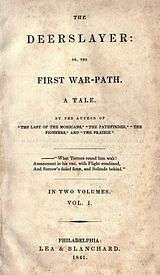The Deerslayer
|
First edition title page | |
| Author | James Fenimore Cooper |
|---|---|
| Country | United States |
| Language | English |
| Series | Leatherstocking Tales |
| Genre | Adventure novel, Historical novel |
| Published | 1841 (Lea & Blanchard: Philadelphia) |
| Media type | Print (Hardback & Paperback) |
| Pages | 560 pp in two volumes |
| Preceded by | The Pathfinder, or The Inland Sea (1840) |
The Deerslayer, or The First Warpath (1841) was the last of James Fenimore Cooper's Leatherstocking Tales to be written. Its 1740-1745 time period makes it the first installment chronologically and in the lifetime of the hero of the Leatherstocking tales, Natty Bumppo. The novel's setting on Otsego Lake in central, upstate New York, is the same as that of The Pioneers, the first of the Leatherstocking Tales to be published (1823). The Deerslayer is considered to be the prequel to the rest of the series. Fenimore Cooper begins his work by relating the astonishing advance of civilization in New York State, which is the setting of four of his five Leatherstocking Tales.
Plot
This novel introduces Natty Bumppo as "Deerslayer": a young frontiersman in early 18th-century New York, who objects to the practice of taking scalps, on grounds that every living thing should follow "the gifts" of its nature, which would keep European Americans from taking scalps. Two characters who actually seek to take scalps are Deerslayer's foil Henry March (alias "Hurry Harry") and the former pirate 'Floating Tom' Hutter, to whom Deerslayer is introduced en route to a rendezvous with the latter's lifelong friend Chingachgook (initially apparent in The Last of the Mohicans). Shortly before the rendezvous, Hutter's residence is besieged by the indigenous Hurons, and Hutter and March sneak into the camp of the besiegers to kill and scalp as many as they can; but are captured in the act, and later ransomed by Bumppo, Chingachgook, and Hutter's daughters Judith and Hetty. Bumppo and Chingachgook thereafter plan to rescue Chingachgook's kidnapped betrothed Wah-ta-Wah (alias 'Hist') from the Hurons; but, in rescuing her, Bumppo is captured. In his absence, the Hurons invade Hutter's home, and Hutter is scalped alive. On his deathbed, he confesses that Judith and Hetty were not his daughters by birth, and Judith determines to discover her natural father's identity; but her search reveals only that her late mother had been of aristocratic descent, and had married 'Floating Tom' after the collapse of an illicit affair. Later, Judith attempts and fails to rescue Deerslayer; and they are all saved at last when March returns with English reinforcements, who massacre the Hurons and mortally wound Hetty. After Hetty's death, Judith proposes marriage to Deerslayer, but is refused, and is last described as the paramour of a soldier. Fifteen years later, Bumppo and Chingachgook return to the site, to find Hutter's house in ruins.
Criticism
The brunt of Mark Twain's satire and criticism of Cooper's writing, Fenimore Cooper's Literary Offenses (1895), fell on The Deerslayer and The Pathfinder. Twain wrote at the beginning of the essay: "In one place in Deerslayer, and in the restricted space of two-thirds of a page, Cooper has scored 114 offenses against literary art out of a possible 115. It breaks the record."[1] He then lists 18 out of 19 rules "governing literary art in domain of romantic fiction" that Cooper violates in The Deerslayer.
In Carl Van Doren's view the book is essentially a romance, at the same time considerably realistic. The dialect is careful, the woodcraft generally sound. The movement is rapid, the incidents varied, and the piece as a whole absorbing. The reality of the piece comes chiefly from the reasoned presentation of the central issue: the conflict in Leather-Stocking between the forces which draw him to the woods and those which seek to attach him to his human kind. Van Doren calls Judith Hutter one of the few convincing young women in Cooper's works; of the minor characters only the ardent young Chingachgook and the silly Hetty Hutter call for his notice.[2]
Adaptations
Film
1913: The Deerslayer, starring Harry T. Morey and Wallace Reid. Filmed at Otsego Lake, the actual setting of the novel. Filmed in 1911, released two years later.
1920: The Deerslayer and Chingachgook, a German film with Béla Lugosi as Chingachgook. This was the first part of the two-part Lederstrumpf silent film.
1943: The Deerslayer, starring Bruce Kellogg and Jean Parker.
1957: The Deerslayer, starring Lex Barker and Rita Moreno.
1967: Chingachgook, die große Schlange, an East German Red Western from DEFA studios, starring Gojko Mitić.
1990: Зверобой, a Soviet version.
Radio
In 1932, the Leatherstocking Tales were adapted as a thirteen-part serial radio drama. It is directed and performed by Charles Fredrick Lindsay and contains both Deerslayer and Last of the Mohicans.
TV
A made-for-television film was released in 1978. The film was directed by Richard Friedenberg and starred Steve Forrest as Hawkeye.
References
- ↑ Twain, Mark. "Fenimore Cooper's Literary Offenses". Mark Twain in His Times. University of Virginia. Retrieved December 6, 2013.
- ↑
 Doren, Carl Van (1920). "Deerslayer, The". In Rines, George Edwin. Encyclopedia Americana.
Doren, Carl Van (1920). "Deerslayer, The". In Rines, George Edwin. Encyclopedia Americana.
External links
| Wikisource has original text related to this article: |
- The Deerslayer at Project Gutenberg
-
 The Deerslayer public domain audiobook at LibriVox
The Deerslayer public domain audiobook at LibriVox
